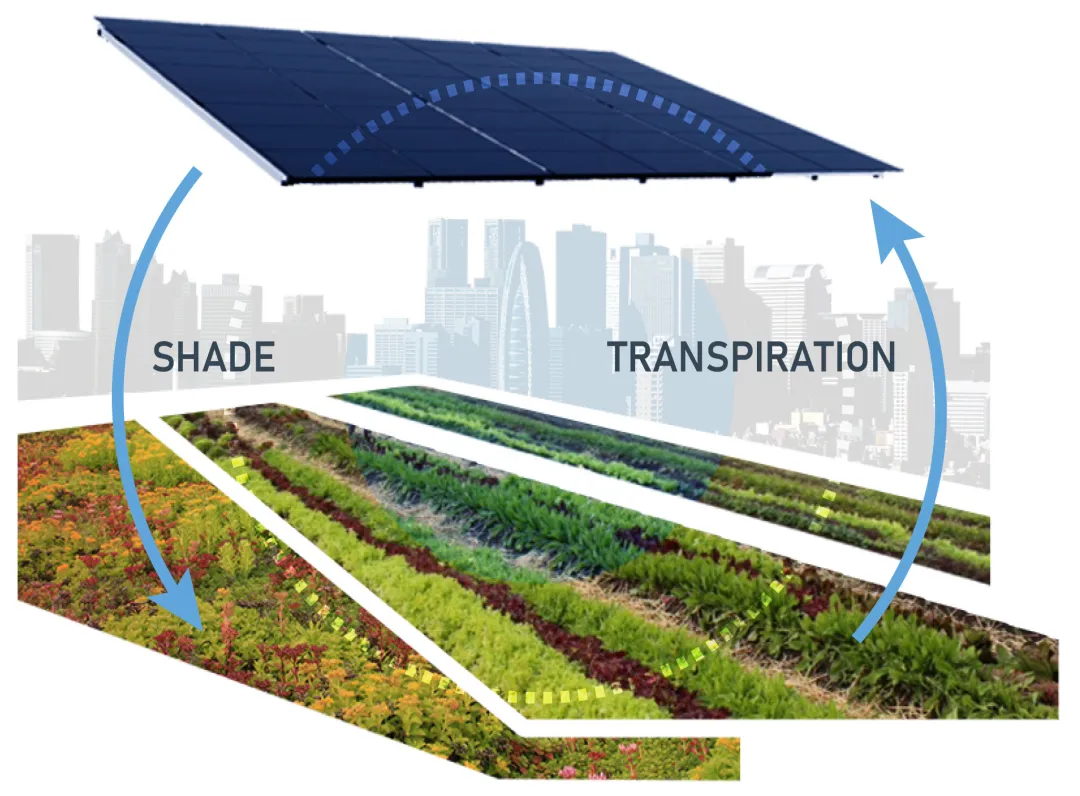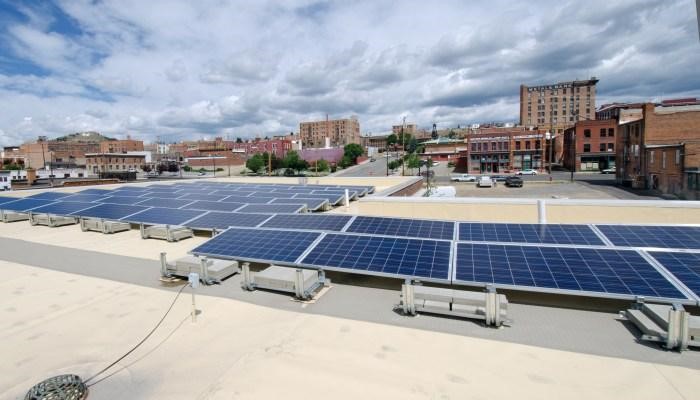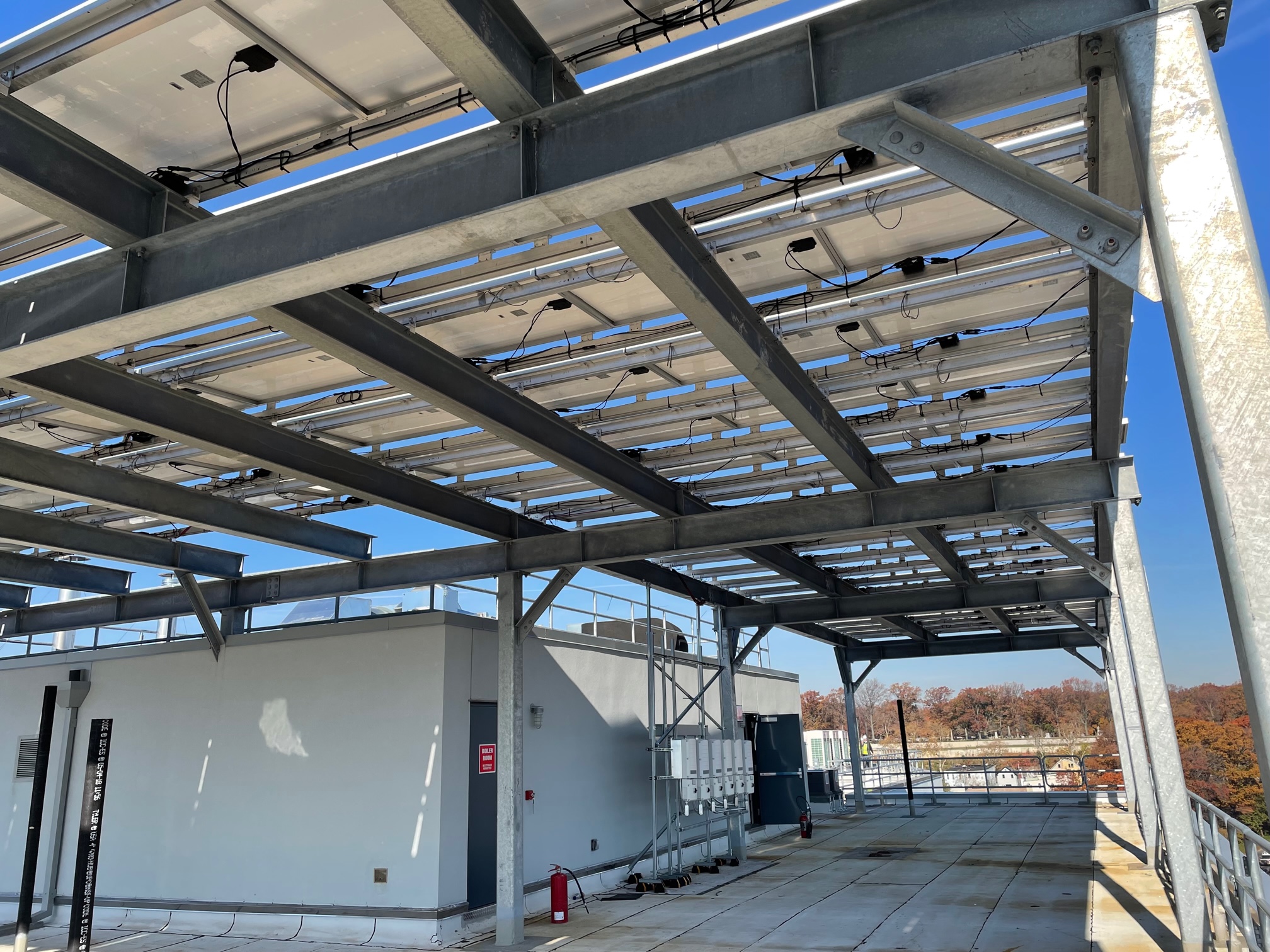All of the Above: Unburdening Overburden Considerations for Commercial Roofing
Blue Roof Considerations
There are a number of considerations for blue roofs to manage rainwater runoff. Including safe rooftop access to the blue roof for maintenance and/or public roof access. The structural load capacity of the roof should also be considered as the retained water on the roof and the catchment system can significantly add weight to the structure. In addition, integrated leak detection strategies and regular inspections and maintenance plans to prevent clogged drains should be incorporated into the design. Considering the longevity and durability of the blue roof accessories and waterproofing layer is of the utmost importance. Leaks are costly to repair and can create a cascade of problems including but not limited to: mold & mildew, poor indoor air quality, corrosion and rotting of building materials, and ultimately structural failure. Extreme care must be taken to ensure that the waterproofing membrane is not damaged. Lastly, rooftop equipment (including solar arrays and electrical connections) should be protected to ensure that it is not damaged as a result of ponding water.9
General Maintenance
According to the New Jersey Stormwater Best Management Practices Manual,
“Blue roofs should be inspected at least four times annually and after every storm event exceeding 1 inch of rainfall. Blue roofs located in areas with significant tree cover or in areas with a high potential for airborne debris may require more frequent inspections due to the potential for clogging. All structural components should be inspected for cracking, spalling and deterioration at least once annually. Disposal of debris, trash, sediment and other waste material must be done at suitable disposal/recycling sites and in compliance with all applicable local, state and federal waste regulations. Access points for maintenance are required on all blue roofs; these access points should be clearly identified in the maintenance plan. In addition, any special training required for maintenance personnel to perform specific tasks should be included in the plan. The design drain time for the maximum design storm runoff volume must be indicated in the maintenance plan. If the actual drain time is longer than the design drain time, the blue roof must be evaluated and appropriate measures taken to return the blue roof to the as-built condition. If the blue roof fails to fully drain within 72 hours, corrective action must be taken and the maintenance manual revised accordingly to prevent similar failures in the future.”10
Potable Water Considerations—NSF P151
Before the introduction of modern drinking water facilities, captured rainwater was one of the best ways to ensure communities had a sufficient supply of water. Parts of the world still rely heavily on rainwater as the main source of drinking water. In order to ensure the safety and health of using captured rainwater for potable water, the NSF established the Rainwater Catchment System Components program, which provides testing guidelines for all components that come into direct contact with rainwater to be used for drinking. The NSF P151 protocol confirms that products do not impart contaminants into the drinking water. When considering using captured rainwater from blue roofs in storage tanks or cisterns, all components should have NSF P151 certification to ensure safe drinking water.11
Blue-Green Roofs
A blue-green roof is a blue roof with a vegetative roof assembly, as well. The added vegetation acts as a biological sponge to reduce the amount of rainwater runoff while, at the same time, slowing the rate at which rainwater runs off. Or, in other words, “The blue green roof combines blue and green roof technologies. Conventional green roofs use a drainage layer to provide lateral drainage and irrigation. Blue roof technology, however, aims to increase both the volume of water stored and control the amount of water released. Combining the technologies can increase the overall benefits of greening roof scapes. Therefore, it is not a case of green or blue infrastructure but a blending of the both”.12
“Blue-green roofs are roof assemblies wherein live vegetation and various substrate layers are used for rainwater detention as part of a stormwater management strategy.13 Blue-green roofs can be distinguished from conventional green roofs in that blue-green roofs provide a larger amount of detention.14 (Temporary storage) of rainwater in addition to existing retention (evaporation) capacities, enhance the roof’s ability to delay and reduce rainwater runoff15 and amplifies the benefits of blue-green roofs in urban areas.”
According to Busker et al, “Runoff reductions during extreme precipitation of 70–97 percent were found.” And, “This is much higher than runoff reductions found for a conventional green roof (12 percent).”16 By reducing runoff, there is less strain on sewer systems and less water flooding impervious surfaces such as streets and hardscapes.
Image courtesy of Buildings
Figure 3: Section detail of a blue-green roof mounted on a conventional roof.
Purple Roofs
A purple roof is a “sponge” roof that incorporates a sponge-like layer made of hydrophilic mineral wool, a dense polyester fabric detention layer, and may or may not include an additional honeycomb layer to increase the volume of rainwater that can be retained and detained and reduces peak outflow by up to 95 percent.17 (See Figure 4).
Image courtesy of Roof Diagnostics, Inc.
Figure 4: Section detail of a purple roof assembly with vegetative roof.
In addition, purple roofs may or may not include a vegetative roof. Pavers on pedestals for amenity decks can also use purple roof strategies.18 (See Figure 5 & Figure 6)
Image courtesy of Roof Diagnostics, Inc.
Figure 5: Section detail of a purple roof assembly with pavers on pedestals.
Photo courtesy of Roof Diagnostics, Inc.
The layers of a purple roof.
According to Brad Garner from Roof Diagnostics, Inc., the hydrophilic needled mineral wool layer can reach 50-60 percent saturation before it starts releasing water, or “outflowing.” Once the mineral wool is saturated, the water flows gravitationally into the honeycomb matrix. The honeycomb matrix can be installed in thicknesses from ½-inch to 4 inches depending on the peak rainfall storage needs of the project. The key differentiating factor of purple roofs is the combination of the mineral wool and the added high density polyester fabric detention layer. The detention layer functions like mini gates to detain the water. The mineral wool then dissipates the detained water through evaporation or evapotranspiration through the vegetated layer. The honeycomb layer is added for extra water storage capacity.
Image courtesy of SemperGreen USA
Figure 6: Example of a purple roof diagrammatic hydrograph showing the slow release of rainwater over several days.
Image courtesy of SemperGreen USA
Figure 7: Example of a purple roof hydrograph showing the peak rain event and the slow release of rainwater runoff over time.
Rooftop Solar
According to SEIA, “Solar power is energy from the sun that is converted into thermal or electrical energy. Solar energy is the cleanest and most abundant renewable energy source available, and the U.S. has some of the richest solar resources in the world. Solar technologies can harness this energy for a variety of uses, including generating electricity, providing light or a comfortable interior environment, and heating water for domestic, commercial, or industrial use.”19 While there are numerous ways to benefit from the solar energy the sun creates including energy generation, hot water, passive solar heat gains, and passive daylighting; for the purposes of this article, photovoltaic energy generation will be the focus.
“Photovoltaic (PV) devices generate electricity directly from sunlight via an electronic process that occurs naturally in certain types of material, called semiconductors. Electrons in these materials are freed by solar energy and can be induced to travel through an electrical circuit, powering electrical devices or sending electricity to the grid.”20 “Photons strike and ionize semiconductor material on the solar panel, causing outer electrons to break free of their atomic bonds. Due to the semiconductor structure, the electrons are forced in one direction creating a flow of electrical current. Solar cells are not 100 percent efficient in crystalline silicon solar cells, in part because only certain light within the spectrum can be absorbed. Some of the light spectrum is reflected, some is too weak to create electricity (infrared) and some (ultraviolet) creates heat energy instead of electricity.”21

Image courtesy of Sandbox Solar
Figure 8: The symbiotic relationship between solar arrays and vegetative roofs.
Solar PV panels come in both single sided and bifacial (double-sided) modules. A bifacial module can produce power from both sides thereby increasing the energy generation. According to Solar Power World, “When bifacial modules are installed on a highly reflective surface (like a white TPO roof or on the ground with light-colored stones), some bifacial module manufacturers claim up to a 30 percent increase in production just from the extra power generated from the rear.”22
Modules are supported by racking systems on the rooftop that are either mechanically attached to the roof, mechanically attached to a structural canopy that is attached to the roof, or held in place with ballast. For ballasted PV racking systems, it is important to consider whether the roof membrane is adhered or mechanically attached, as discussed in this article. Mechanically attached membranes can billow or flutter in wind events which could put a ballasted solar array in jeopardy of flipping or breaking electrical connections. In addition, the constant movement of ballasted arrays on mechanically attached membranes can damage the waterproofing layer by friction or puncture. Using an adhered roof membrane for ballasted solar arrays can help limit the risk of damage from wind.

Photo courtesy of GAF
A mechanically attached solar PV array.

Photo courtesy of GAF
A ballasted solar PV array.

Photo courtesy of Shawn Torbert
A solar array on a raised structural canopy.








